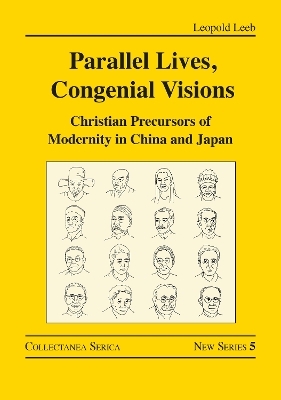
Parallel Lives, Congenial Visions
Routledge (Verlag)
978-1-032-62198-2 (ISBN)
The Chinese and Japanese men and women presented in this book are outstanding personalities who tried to open up the road to international relationships, pioneers in their respective domains who introduced Western culture to their nations, precursors who strove for modernization, e.g., in the fields of translation, education, medicine, media, and social welfare. They testify to individual agency in these cross-cultural exchanges. Many of those who tried to be “cultural bridge-builders” since the 16th century were Christians, simply because the missionaries, who worked hard to learn the native languages of China and Japan, were the first to introduce new cultural elements to these countries. The universal scope and vision of the Christian faith enabled both missionaries and native believers to overcome narrow nationalism or xenophobia and turned them into cross-cultural mediators.
Leopold Leeb studied philosophy and theology in Mödling (near Vienna) and Chinese philosophy at Fu Jen Catholic University, Taipei, and at Beijing University. He received his Ph.D. from the latter with a dissertation on the Han dynasty mathematician, astronomer and writer Zhang Heng. From 1999 till 2004 he worked as a researcher and translator at the Chinese Academy of Social Sciences. Since 2004 he is professor at Renmin University, Beijing, where he teaches Latin, Ancient Greek, Ancient Hebrew, and the history of Western literature. His research also focuses on the history of Christianity in China. He has published widely in China, among others an introduction to the language and thought of the Bible, language courses in Latin, Latin dictionaries, a dictionary on Chinese theology and the series “English-Chinese Summaries of Western Classics,” of which volume 5 has been published 2020. Recently, he published the monograph One Dragon, Two Doves: A Comparative History of the Catholic Church in China and in Vietnam (2022).
Preface by He Guanghu
Preface by Muraoka Takamitsu
Preface by the Author
Introduction
Chapter One: The Trailblazers’ Guides: Anjirō (ca. 1520–1565) and Zhong Mingren (1562–1621)
Chapter Two: The First Translators of European Texts: Yohoken (ca. 1510–1596) and Xu Ruohan
(ca. 1670–1740) 9
Chapter Three: Noble Promoters of Military Reforms: Ōtomo Sōrin (1530–1587) and Xu Guangqi
(1562–1633)
Chapter Four: “Grace” and “Brilliance”: Hosokawa Garasha (1563–1600) and Candida Xu
(1607–1680)
Chapter Five: Pioneers of Comparative Philosophy: Fukansai (1565–1621) and Yang Tingyun
(ca. 1557–1628)
Chapter Six: The First Native Priests: Kimura (1565–1622) and Luo Wenzao (1617–1691)
Chapter Seven: The First Travelers to Europe: Itō Mancio (1569–1612) and Zheng Manuo
(1633–1673)
Chapter Eight: Precursors of the Internationalization of the Script: Dourado (1567–1620) and
Wang Zheng (1571–1644)
Chapter Nine: The First Editors of Bilingual Dictionaries: Martin Hara (1568–1629) and
Huang Risheng (1679–1716)
Chapter Ten: The Earliest Celebrities in Europe: Hasekura Tsunenaga (1571–1622) and
Shen Fuzong (ca. 1658–1692)
Chapter Eleven: Western Art in the East: Jacobus Niva (Ni Yagu, 1579–1638) and You Wenhui
(1575–1633)
Chapter Twelve: Hope of the Suppressed: Amakusa Shirō (1622–1638) and Wang Maria
(ca. 1855–1900)
Chapter Thirteen: Interrogation of a Messenger from the West: Arai Hakuseki (1657–1725) and
Kangxi (r. 1662–1722)
Chapter Fourteen: Early Students of Western Medicine: Gao Leisi (1732–1795), Yang Dewang
(1733–1798), and Sugita Genpaku (1733–1817)
Chapter Fifteen: The First Teachers of Western Languages: Ogata Kōan (1810–1863) and Xue Madou
(ca. 1780–1860)
Chapter Sixteen: Organizers of Modern Media: Fukuzawa Yukichi (1835–1901) and Ying Lianzhi
(1866–1926)
Chapter Seventeen: Creators of Universities: Yan Yongjing (1838–1898) and Niijima Jō
(1843–1890)
Chapter Eighteen: Entrepreneurs and Philanthropists: Shibusawa Eiichi (1840–1931) and Lu Bohong
(1875–1937)
Chapter Nineteen: The First Female Physicians: Ogino Ginko (1851–1913) and Jin Yamei (1864–1934) 135
Chapter Twenty: Pioneers of Women’s Education: Tsuda Umeko (1864–1929) and Zeng Baosun
(1893–1978)
Chapter Twenty-One: Faith on the Way to Inculturation: Uemura Masahisa (1858–1925) and Zhao Zichen
(T.C. Chao, 1888–1979)
Chapter Twenty-Two: Fathers of Constitutional Law: Ume Kenjirō (1860–1910) and Wu Jingxiong
(1899–1986)
Chapter Twenty-Three: Creators of an Image of the East: Nitobe Inazō (1862–1933) and Gu Hongming
(1857–1928)
Chapter Twenty-Four: Independent Prophets: Uchimura Kanzō (1861–1930) and Wang Mingdao
(1900–1991)
Chapter Twenty-Five: Pioneers in the Study of History: Saeki Yoshirō (1871–1965) and Chen Yuan
(1880–1971)
Chapter Twenty-Six: The First Students of Classical Hebrew: Kotsuji Setsuzō (1887–1965) and
Li Rongfang (1899–1973)
Chapter Twenty-Seven: Indigenization of Christian Art: Chen Yuandu (1903–1967) and Watanabe Sadao
(1913–1996)
Chapter Twenty-Eight: A Life for the Poor: Wu Yongbo (1916–2002) and Kitahara Satoko (1929–1958)
Conclusion: Two Nations on the Way to Modernity
| Erscheinungsdatum | 09.04.2024 |
|---|---|
| Reihe/Serie | Collectanea Serica. New Series |
| Zusatzinfo | 2 Tables, black and white; 41 Halftones, black and white; 41 Illustrations, black and white |
| Verlagsort | London |
| Sprache | englisch |
| Maße | 174 x 246 mm |
| Gewicht | 1550 g |
| Themenwelt | Literatur ► Biografien / Erfahrungsberichte |
| Sachbuch/Ratgeber ► Geschichte / Politik | |
| Geisteswissenschaften ► Geschichte ► Regional- / Ländergeschichte | |
| Geisteswissenschaften ► Religion / Theologie | |
| Sozialwissenschaften ► Soziologie ► Spezielle Soziologien | |
| ISBN-10 | 1-032-62198-2 / 1032621982 |
| ISBN-13 | 978-1-032-62198-2 / 9781032621982 |
| Zustand | Neuware |
| Haben Sie eine Frage zum Produkt? |
aus dem Bereich


